Ray
23rd August 1919 Saturday
Packing Up
All material produced or reproduced here and throughout this work is the sole copyright of the author and the family of Doctor D.C.M. Page MC
“We closed down our hospital on the 23rd August, and were busy after that in finding something to do to kill the time. We played bridge a lot and went for long walks.”
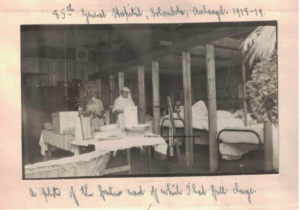
Find out about our connection with Dr Page and an introduction to his diary here
17th August 1919 Sunday
“Rawly” Pays a Visit
All material produced or reproduced here and throughout this work is the sole copyright of the author and the family of Doctor D.C.M. Page MC
“General Lord Rawlinson and his staff and many other red, blue and green tabs paid us a visit on the 17th. We all had tea in the Recreation Room afterwards. The General shook hands with me, and was surprised when I told him that I’d been out here a year. I hope he gets a move on and sends me home soon!”
The “red blue and green tabs” gorget patches were mentioned on the 20th December 1915. However, the red blue and green tabs could have been from varying origins, most likely red were the Officers of the General Staff also with variations Royal Artillery and Royal Engineers. Blue had various incarnations with different shades and trimmings possibly signifying medical staff colonels, Pay corps, or Instructors. Green could represent Dentists or Intelligence officers. It seems many departments were represented on the visit.
Find out about our connection with Dr Page and an introduction to his diary here
11th August 1919 Monday
“Rawly” Arrives
All material produced or reproduced here and throughout this work is the sole copyright of the author and the family of Doctor D.C.M. Page MC
“About this time strong rumours of the British evacuation shortly of Archangel and district were going about. I heard that all British civilians had been ordered, or advised to leave within a month. Several British families, including the Carrs, (of Steuart’s timber yards) left on the 11th August.
I heard about this time too some details of the Bolo success at Onega, which village on the White Sea was taken from us recently. The Bolo success was, as usual, due to the fact that our gallant Russian Allies deserted us at the critical moment. Some of these deserters were being brought to Archangel on the ‘Walton Belle’ when they mutinied, and killed the British sergeant in charge, and wounded others of the escort. H.M.S. ‘Fox’ luckily arrived on the scene, and the O.C. sent an armed party aboard. They saw red, and not one of these Russian traitors lived to tell the tale.
On Monday August 11th General Rawlinson and his staff arrived on board the ‘Czaritza’. He has come out to superintend the safe evacuation of the British forces – so rumour has it. At our Hospital we have closed down most of the wards, and have stared packing up some of the equipment.“
Another paddle steamer brought to cope with the shallow waters of the Dwina was the Walton Belle, a smaller boat than the London Belle that we dealt with on the 2nd August. London Belle had been fitted with 165 beds and less were fitted into the Walton Belle. The diary of seaman Ethelbert Daish http://ethelbertsdiary.co.uk/?page=home confirms that paddle steamers had to make the journey out in short hops, clearly to take on supplies, water and fuel in order to make such a long trip. I heartily advise readers to visit the online diary to further their experience and knowledge of the North Russian expedition. Ethelbert tells us further of unrest and mutiny. Thank you to our Archangel correspondent Dmitry Bychiknin for alerting us to this diary.
HMS Fox was mentioned on the 15th May and Czaritza on the 26th/27th May.
The arrival of General Rawlinson saw one of Britain’s top military men come to oversee the withdrawal of the allied forces. It’s difficult to understand why it was necessary to send for a hero of the Boer War, Neuve Chapelle, The Somme and many other battles throughout the conflict on the Western Front the most experienced and battle hardened General the British army possessed when the operation in northern Russia was coming to a close. However, it must have been a boost to moral to have one of Britain’s most experienced Generals arriving to take over operations.
Known as Rawly to his confidents, General Sir Henry Seymour Rawlinson now simply Lord Rawlinson had excelled in his duties during the Second Boer War and worked his way steadily through the ranks. By the beginning of the Great War he had achieved the rank of Major General although this was by the usual British method of promotion, temporary and Brevet ranks. This was the British army’s normal way of promotion by giving an honorary position which came with the power of rank, but not the pay grade. Only permanent gazetted promotion to a rank ensured that the appropriate pay accompanied the title. So it wasn’t until 1917 that he was given the permanent rank of General, following all his successes and failures over the course of the war.
1918, however brought most of his military successes with his victories at the Battle of Amiens. By now General Hubert Gough had been relieved of his command and Haig had given Rawlinson almost complete command of the allied forces in France. Lessons of the Somme and Passchendael had been learned, but German moral at this time was at a very low ebb. The German commander Ludendorff described Amiens as a “Black day for the German Army”.
So the arrival of Rawlinson, one of the most famous men of WW1 would have been seen by the men remaining in Russia as a high point and resulted in a lifting of spirits.
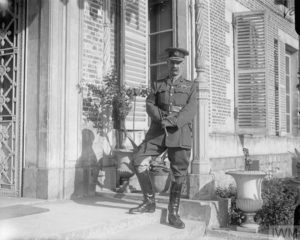
British Army General Henry Rawlinson at his Fourth Army headquarters at Querrieu Chateau.
(Q 4032) © IWM. Original Source: http://www.iwm.org.uk/collections/item/object/205125115
Find out about our connection with Dr Page and an introduction to his diary here
2nd August 1919 Saturday
A Jittery Time in Archangel and Solombola
All material produced or reproduced here and throughout this work is the sole copyright of the author and the family of Doctor D.C.M. Page MC
“Saturday, August 2nd, was a day of terrific ‘wind-up’ with us. G.H.Q. spies had informed us that this was the day on which the British, especially the officers were to be wiped off the map! Our Commanding Officer was in a terrific state of alarm! He had convalescent patients busy for several days beforehand putting up barbed wire entanglements all round the hospital. On our mess balcony a sand-bagged machine-gun emplacement was built, and armed sentries were posted all over the place. These men didn’t know how to handle a rifle, and I quaked when I passed them by even in daylight. We were all put through a course of machine-gun drill, but I’m afraid none of us would have been of much use with the gun, if the necessity had arisen. Lt. Commander Richardson, my naval friend, was in charge of a hospital ship, ‘The London Belle’. lying off Solombola ready to take all our patients on board if necessary. American sailors, armed to the teeth, patrolled the streets all day, and British armoured cars dashed about at top speed. Archangel was deserted, many civilians having fled to the country, fearing trouble. Of course nothing happened. Some of the red-tabs at G.H.Q. must have a guilty conscience!”
Commander Richardson* our heroic naval character was in command of the paddle steamer London Belle at this time. This was a remarkable thing because she was such a tiny vessel. Tiny, but the Navy realised that it was exactly what they needed on the treacherously difficult Dwina. Frozen for eight months of the long winter, the summer was equally demanding. The water level steadily dropped throughout the hot summer making navigation for all but almost flat bottomed boats impossible and small paddle steamers with their low draft were ideally suited. The added difficulty would have been sailing the tiny craft on such a long journey from its home waters of London’s Thames to Archangel. It must have taxed the coal fuel capacity to its limits.
London Belle was launched on the 10th March 1893 by William Denny Bros. of Dumbarton for the London, Woolwich and Clacton-on-the-Sea Steamboat Company Ltd., She was built for use as a passenger steamer on the River Thames as an alternative to the railways for journeys to Southend and Clacton, becoming popular with day trippers, leaving Fresh Wharf at 09.30 daily. Fresh Wharf was situated on the north side of the Thames between Tower and London bridges. It closed in 1970.
The London Belle at 738 grt tons was the largest of the steamers used on this service. Even though she was over 280 ft (85.5 mtrs) in length, it was still a tenth of the size of the Kalyan. The Navy requisitioned her for use as a minesweeper in 1916 before returning her to her then owner the Coastal Development Corporation Ltd. in May 1919 only to take her straight back and send her to Archangel for use as a hospital ship.
She was eventually demobilised in 1920. Eventually being broken up on the Thames in 1929.
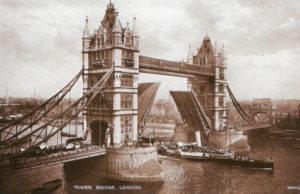
London Belle passing under Tower Bridge en-route down river. (An uncredited postcard)
Find out about our connection with Dr Page and an introduction to his diary here
28th July 1919 Monday
An Emptying Hospital Gives Time For a Swim
All material produced or reproduced here and throughout this work is the sole copyright of the author and the family of Doctor D.C.M. Page MC
“Next day the ‘Khalyan’ left for home with many wounded on board. Some of our officers went also, but still I remained. Things were very slack in hospital as we had evacuated most of our patients to the ‘Khalyan’. Most of us were able to get away for a bathe on Moses Island every day. We took it in turns to stay behind as Orderly Officer.”
The pictures below show Lt. Herman whilst bathing on Moses Island and his impersonation of Lady Constance Stewart-Richardson 1883-1932. Lady Constance was a controversial dancer, the daughter of nobility who married an officer of the Black Watch who was killed at the First Battle of Ypres in 1914. Her scantily clad theatre performances brought about the wrath of Edward VII who banished her from court, despite his own behaviour which might seem a little hypocritical these days.

Lady Constance Stewart-Richardson. Bain News Service [Public domain]
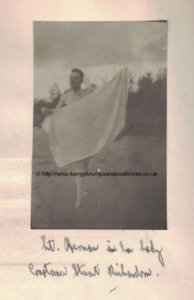
Lt. Herman’s version of her
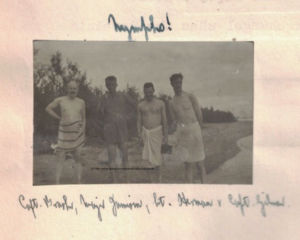
Nymphs.
Capt. Brasher, Major Jamieson, Lt. Herman and Captain Gilmour bathing on Moses Island
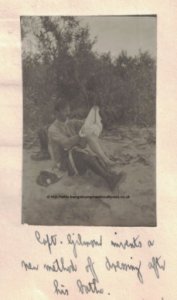
Captain Gilmour invents a new method of dressing after his bathe.
Find out about our connection with Dr Page and an introduction to his diary here
27th July 1919 Sunday
A Noisy Dinner and More Fire!
All material produced or reproduced here and throughout this work is the sole copyright of the author and the family of Doctor D.C.M. Page MC
“On the evening of July 27th we entertained our sisters to dinner. Twenty-two of us sat down to dinner, and once we all got warmed up the noise was terrific. One couldn’t hear oneself eat! After dinner we had games and dancing. As an interlude the local Russian picture-house behind the mess caught fire, and made a grand blaze.”
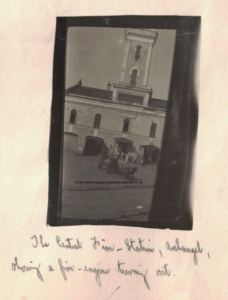
The Central Fire Station, Archangel, showing a fire-engine turning out.
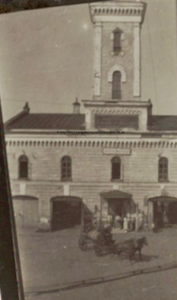
Find out about our connection with Dr Page and an introduction to his diary here
23rd July 1919 Wednesday
Situation Report
All material produced or reproduced here and throughout this work is the sole copyright of the author and the family of Doctor D.C.M. Page MC
Below is a copy of the original report unfortunately a slightly cropped photo. The transcript is included below.
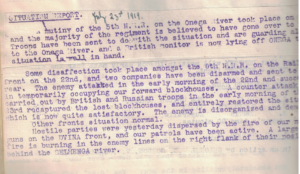
“… A mutiny of the 5th N.R.R. on the Onega River took place on the 21st and the majority of the regiment is believed to have gone over to the enemy. Troops have been sent to deal with the situation and are guarding all approaches to the Onega River and a British monitor is now lying off ONEGA town. The situation is well in hand.
Some disaffection took place amongst the 6th N.R.R. on the Railway front on the 22nd and two companies have been disarmed and sent to the rear. The enemy attacked in the early morning of the 22nd and succeeded in temporarily occupying our forward blockhouses. A counter attack carried out by British and Russian troops in the early morning of the 23rd recaptured the lost blockhouses, and entirely restored the situation, which is now quite satisfactory. The enemy is disorganised and demoralised.
Other fronts situation normal.
Hostile parties were yesterday dispersed by the fire of our naval guns on the DVINA front, and our patrols have been active. A large forest fire is burning in the enemy lines on the right flank of their position behind the SELMENGA river.”
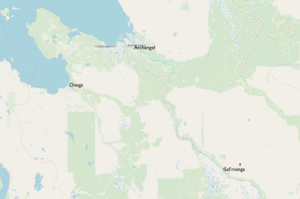
(c) OpenStreetMap contributors
Find out about our connection with Dr Page and an introduction to his diary here
17th July 1919 Thursday
More Departures and Uncomfortably Hot
All material produced or reproduced here and throughout this work is the sole copyright of the author and the family of Doctor D.C.M. Page MC
“The heat was greater than ever now – over 100o in the shade, and absolutely broiling in the sun. The ‘Czar’ left for Blighty on the 17thJuly packed with troops, including some of our officers and men, and Count Campello. I was left behind as usual!”
Details of the Czar can be found here
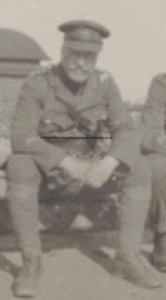
Count Campello
Find out about our connection with Dr Page and an introduction to his diary here
11th July 1919 Friday
Mutiny and Murder!
All material produced or reproduced here and throughout this work is the sole copyright of the author and the family of Doctor D.C.M. Page MC
“On July 11th a big convoy of wounded arrived at our Hospital from Beresnik. Most of them were Russians with self-inflicted wounds of the left hand. We got definite news of the mutiny of the Russian troops up at Beresnik. The Bolsheviks made a big attack, and our gallant Russian allies allowed the enemy to advance right through our lines, afterwards joining hands with the Bolos. Six British officers were murdered in their sleep, and nine others escaped with wounds. Many British soldiers were wounded. The mutinous troops got right down to our gunboats, which they peppered with machine-gun bullets. Many sailors were killed, or wounded. On the way down the river some of the Russian wounded tried to escape. One jumped overboard, and escaped by being picked up by a passing boat. Obviously we have not many friends out here now. We heard too that the Bolsheviks had captured Perm, and that Kolchak’s Army was in retreat. It is about time we cleared out of here!”
The mutiny at Beresnik on July 7th, was a devastating blow to all out in Russia. Dyer’s battalion of whom so much had been trusted had carefully chosen their moment to throw off their sheep’s clothing and pounce like a hungry wolf.
At about half two in the morning eight men from B Company 1st Slavo-British Regiment acting under a corporal Nuchev entered the officers’ billet. The officers of two companies B and C of the battalion were sleeping there. Nuchev shot through a window and killed Captain Aubrey Malcolm Cecil Finch (1) aged 22 as he slept. This was the signal for his accomplices to attack. Three orderlies and three more British officers were shot dead and a further two fatally wounded. At the far end of the room were the Russian officers three of whom were also shot dead and one wounded. The rest of the battalion had by now fallen in and encouraged to join the mutineers in defecting to the Bolsheviks. About twenty of B company agreed to follow and escape to behind the enemy lines. A period of about twenty minutes then passed before they were joined by about another fifty from C company. All in all about a hundred defected. It seems that the mutiny had only originated from B company and the intention was merely to defect as soon as possible.
Captain David Buik Barr aged 25 (2), one of the officers wounded in the attack managed to escape despite being shot and stabbed seven times and swam across the river to alert others in a moored boat as to what had occurred. He had made it to safety and was visited later that day in his hospital bed by Ironside who informed him that he was to be awarded a Military Cross for his efforts.
The other British officers killed were Lt. Gerald Noel Gosling aged 21 (3) Lt. Cecil Francis R. Bland MC aged 21 (4) and Lt. Thomas Comber Griffith aged 24 (5).
To the Allies the news that British officers and men were brutally murdered by men they thought were on their side was an enormous shock. However, the betrayal of trust and the failure to spot the Bolshevik infiltration into the Slavo-British Regt. was a massive blow to allied morale. General Ironside referred to the battalion as “The Experiment” and even after he had expressed massive disappointment at its failure still felt that it was a concept that could be explored in the future.
Douglas’s comment that “It’s about time we cleared out of here” would have reverberated throughout Archangel.
The dream of linking up with Kolchak’s White Army as they fought their way north, but now stalling and in retreat, was now exactly that.
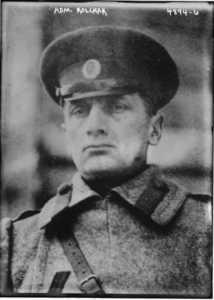
Supreme Leader of White Russia Admiral Alexander Kolchak
(1) Capt. A.M.C. Finch Buried Allied Cemetery Archangel plot B40
(2) Capt. D.B. Barr Buried Allied Cemetery Archangel plot L2
(3) Lt. G. Gosling Buried Allied Cemetery Archangel plot B49
(4) Lt. C.F.R. Bland Buried Allied Cemetery Archangel plot B9
(5) Lt.Thomas Griffith Buried Allied Cemetery Archangel plot
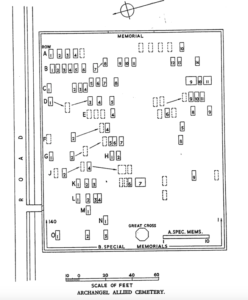
Guide to the Archangel Allied Cemetery.
Visitors to the War Cemetery in Archangel will benefit from this useful information provided by the Commonweath War Graves Commission.
https://www.cwgc.org/find-a-cemetery/cemetery/54102/ARCHANGEL%20MEMORIAL
Archangel, in the north of the Russian Federation, is a town on the eastern side of the Dvina Estuary on the White Sea. The Archangel Memorial is at the far end of Archangel Allied Cemetery, which is on the north-west outskirts of the town of Archangel, adjoining the Lutheran and Russian cemeteries and memorials to those who died in more recent actions. From the railway station, travel along the main road towards the River Dvina. Halfway along this road take the turning on the right hand side called Obvodnyi Kanal Avenue. The cemetery will be found on the right hand side of this road.
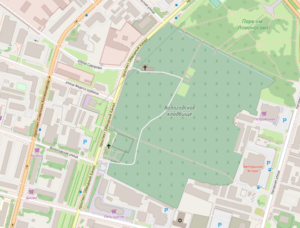
(c) OpenStreetMap contributors
Find out about our connection with Dr Page and an introduction to his diary here
3rd July 1919 Thursday
Fire!
All material produced or reproduced here and throughout this work is the sole copyright of the author and the family of Doctor D.C.M. Page MC
“On the evening of July 3rd we all got a big fright. The large wooden dwelling-house behind our mess went on fire, and was soon blazing away merrily. We all dashed out, and helped to get some of the furniture out of the house. It must have been humorous to see two of us trying to carry out the grand piano! We had to stop the good work on account of the great heat. British Naval Units greatly helped the Russian Fire Brigade by bringing up a line of hose from a boat at the riverside. One woman had to be rescued from a top window by ladder. A British sailor did the trick, and was warmly cheered. Huge crowds gathered to watch the blaze.”
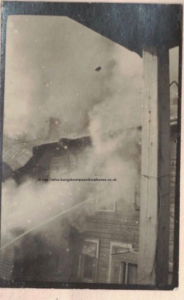
The fire raging.
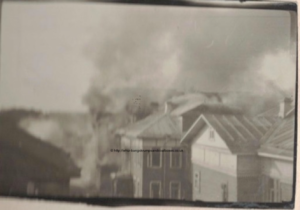
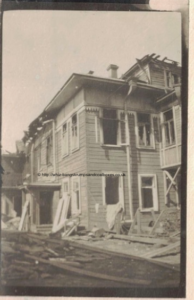
Aftermath
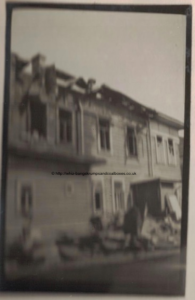
Find out about our connection with Dr Page and an introduction to his diary here